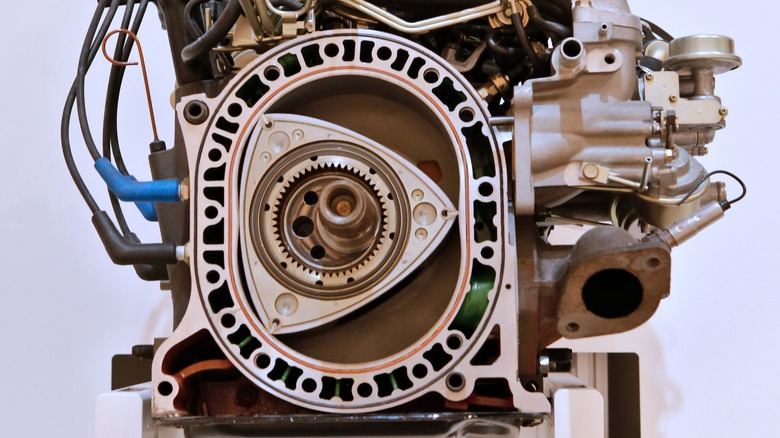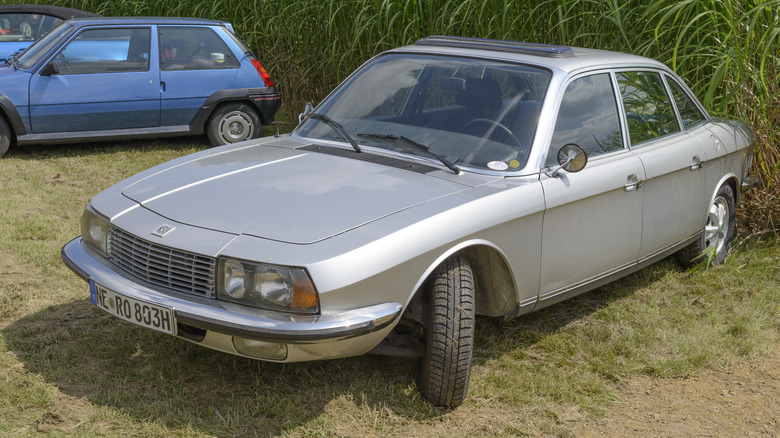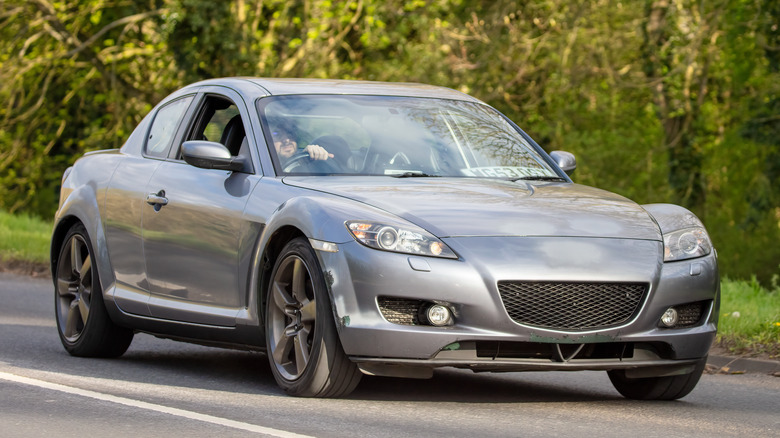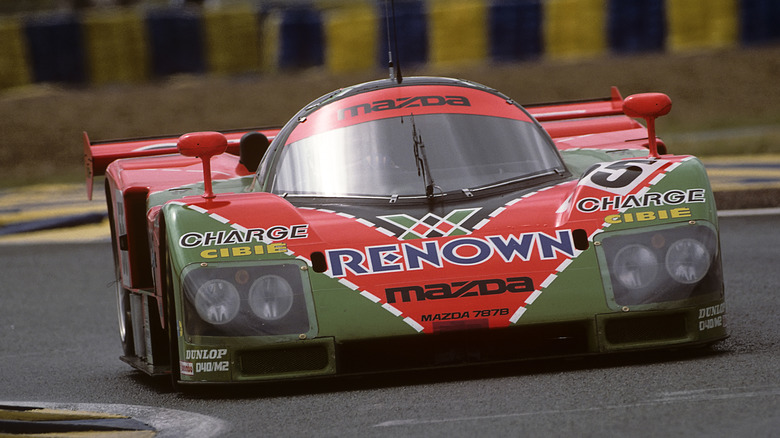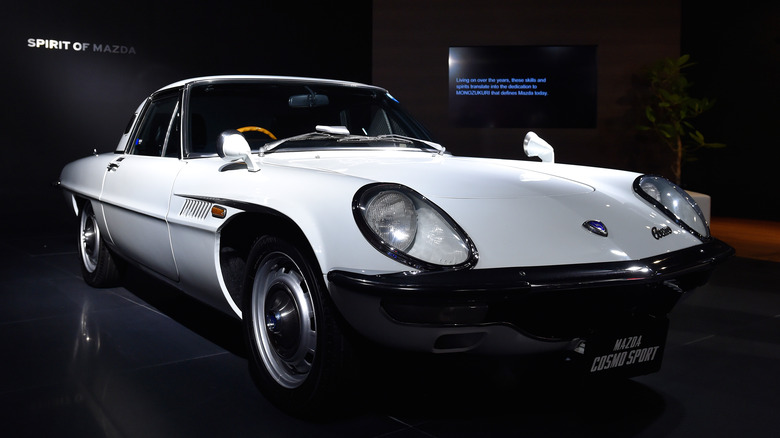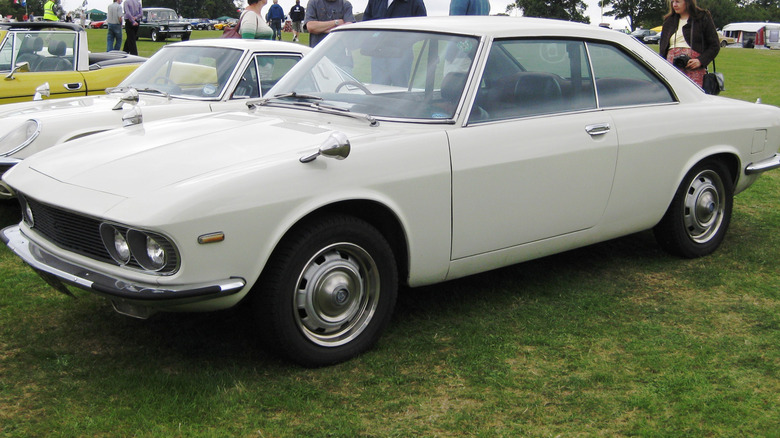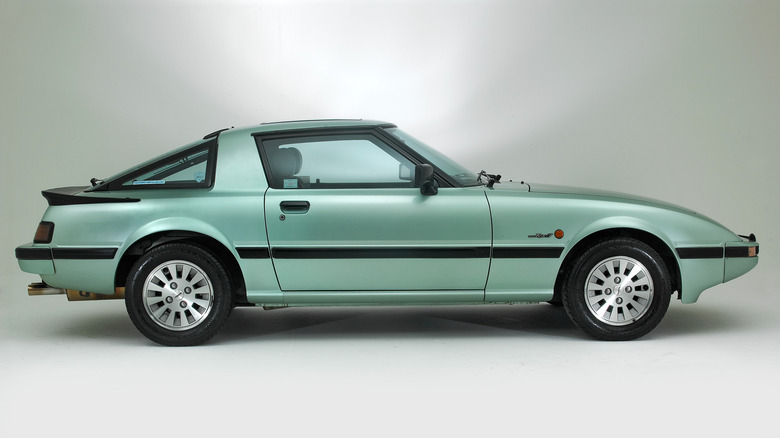6 Of The Best Cars Ever Built With Rotary Engines
Most vehicles use a piston engine similar to the one-cylinder, four-stroke motor in the first car ever made, Karl Benz's Patent Motorwagen. Lately, a more fuel-efficient and emissions-friendly engine design, the opposed-piston engine, has been gaining ground with commercial fleets. However, one engine format that never quite took hold in the auto industry is the Wankel rotary engine. This engine uses a triangular piston that meshes directly with the crankshaft and rotates within an oval-shaped cylinder. It was invented in the 1920s by self-taught German engineer Felix Wankel, who completed his first prototype in 1954 while working for the NSU Motorenwerk Auto Group.
In the early '60s, Mazda bought the technology from NSU, and in the following decades, it produced more viable rotary-powered vehicles than any other automaker, including the RX-7 sports car and REPU (Rotary Engine Pick Up) truck. Although Mazda carried the banner for rotary engines through the latter part of the 20th Century, its cars were far from the only notable ones to use Wankel's design. Still, it would be impossible to catalog the best cars to use rotary engines without including mostly Mazdas.
NSU Ro 80
Wankel's company, NSU, was unsurprisingly the first to use the rotary engine in a production car. Wankel's first single-rotor production engine weighed only 125 kilograms (about 276 pounds) and was small enough to fit under the floor of the 1964 NSU/Wankel Spider roadster. NSU only made 2,375 Spiders through 1967, when development attention was shifted to a new model, the Ro 80. The Ro 80 was designed by Claus Luthe, who also crafted the absolutely marvelous BMW E30 3-Series. NSU unveiled the Ro 80 at the 1967 Frankfurt Motor Show, and Car Magazine praised the sleek design in naming the Ro 80 its Car of the Year. The article announcing this honor noted that NSU had made good on its "desire to accentuate rather than disguise the presence of the rotary engine."
Car's editors noted that the Wankel engine's smooth operation was most noticeable at more than 100 mph, writing, "It is as relaxed and quiet as any car we know at that speed, and really does introduce you to a new experience." One notable flaw was that the Ro 80's original three-tipped rotors were prone to excessive wear at the tips, forcing NSU to perform plenty of warranty repairs and eventually redesign the rotors in the late '60s. NSU became part of the Audi Group in 1969, and the Ro 80 faded into obscurity.
Mazda RX-8
Any list of rotary-powered success stories must include the Mazda RX-8. Mazda introduced it in 2004 as a four-door coupe with reverse-hinged suicide doors in the rear. It had a 1.3 liter twin-rotor 13B engine that sat mostly behind the front axle for improved balance. The RX-8 had a newly designed multi-link suspension and lightweight bodywork with noise-deadening floor panels. The six-speed manual transmission-equipped RX-8s had an engine tuned to produce 238 horsepower, while the paddle-shift automatic versions produced only 197 horsepower.
The RX-8's engine was notorious for consuming oil and gasoline but delivered exhilarating performance. Car and Driver's Aaron Robinson took it on a long-term test drive and noted, "The RX-8 plants four feet in a wide, stable stance and charges, its twin rotors gyrating to 9000 rpm. ... Relatively featherweight, always agile, and remarkably stiff with finger-flick steering, the RX-8 is constantly hunting for the next apex."
Mazda dropped the RX-8 and the 13B rotary engine after the 2012 model year but continued making parts for the 13B through 2021, hand-assembling them into complete engines, even though they were not destined for any cars. In a feature on Mazda's website, longtime rotary engineer Tetsuya Sato said, "This small team makes all the parts needed for a rotary engine. ... It's not easy, but ... we're in it together. Everyone on the team is unique — it's a fun place to work."
Mazda 787B
Unless you're a world-class endurance racer, you'll likely never get to drive one of Mazda's best rotary engine-powered cars. In 1991, the Mazda 787B made history as the first Japanese-made car to win the 24 Hours of Le Mans, one of motorsport's greatest races. Mazda entered two 787Bs in the race that year. Both vehicles were powered by 2.6-liter four-rotor engines that produced 900 horsepower but were detuned to 700 horsepower so they could last the entire race. The winning No. 55 car pictured above was driven by a team made up of Formula 1 veterans Volker Weidler, Johnny Herbert, and Bertrand Gachot.
The No. 55 car took the lead late in the race when the Mercedes ahead had to retire because of overheating issues. After the 1991 race, the FIA announced that rotary engines would no longer be allowed at Le Mans, so this was Mazda's first-and-only win at Le Mans with the technology. The rotary ban stayed in effect through 2021, when the FIA quietly opened the door for Wankel engines again. In 2023, the No. 55 787B returned to Le Mans to take a few demonstration laps in celebration of the race's centennial and run in the Le Mans Classic.
Mazda Cosmo Sport
Mazda President Tsuneji Matsuda shocked those in attendance at the Tokyo Motor Show in the fall of 1963 when he drove the Cosmo Sport into the exhibit hall. The model wasn't officially launched until May of 1967 due to the need to iron out a few bugs of the first two-rotor rotary engine to go into a production car. The 982 cubic centimeter 10A engine produced 130 horsepower and 103 pound-feet of torque, just enough to get the 940-kilogram (2,072-pound) Cosmo to 60 mph in 8.2 seconds.
Once the Cosmo Sport went into production, Mazda built every copy by hand, which kept production to about one unit per day. By the time the model's run ended in 1972, only about 1,500 had been made, but more Cosmos were on the way. The Cosmo AP (for anti-pollution) was released in 1975 and won Motor Fan Magazine's Car of the Year award. In 1977, Mazda added a luxury version, the Cosmo L. A redesigned version came in 1981 that included improvements to the aerodynamic profile, reducing the drag coefficient to 0.32. A newer version, the Eunos Cosmo, appeared in 1990 with a twin-turbo three-rotor rotary engine and the auto industry's first in-dash GPS.
Mazda Luce R130
Mazda only made one rotary-powered front-wheel drive car, the Luce R130. The Luce (Italian for "light") was a luxury coupe designed by Giorgetto Giugiaro, who also created the Volkswagen Golf, Lotus Esprit, Ducati 860 GT/GTS, and BMW M1. Fewer than 1,000 units were built during the Luce's brief run from 1969 through 1972, and only around 200 are thought to still exist. The 13A twin-rotor rotary engine in the Luce displaced 1.3 liters, putting out 124 horsepower and 127 pound-feet of torque. It was never used in another car.
The Luce's 13A was topped by a Hitachi-Stromberg four-barrel carburetor. So equipped, the Luce could go from 0 to 60 mph in 8.3 seconds and hit a top speed of 119 mph. It was only sold in Japan and had a sticker price of 1.75 million yen. Accounting for inflation and currency conversion, that equates to around $40,000 today.
Mazda RX-7
The most successful rotary-powered car of all time is undoubtedly the Mazda RX-7. It debuted in 1978 and lived through three generations before being discontinued in 2002 after a global production run of more than 800,000 units. Until 1984, all RX-7s were powered by the 12A engine, but buyers that year who chose the GSL-SE trim package got a 135 horsepower version of the 13B. The second generation RX-7 appeared in 1986, and that year Motor Trend named the RX-7 its Import Car of the Year. A turbocharger was added the following year, boosting output to 182 horsepower and cutting the RX-7's 0 to 60 mph time to under 7 seconds. The third generation premiered in 1992, and the following year brought another Motor Trend Import Car of the Year award. Mazda sold just over half a million RX-7s in the United States during its run, but less than 14,000 were third-gen models.
The RX-7 was a racing juggernaut, taking the top two spots in the GTU class at the 1979 24 Hours of Daytona. Drivers in RX-7s also won the IMSA GTU championship every year from 1980 through 1987 and took the GTO championship in 1984 against cars with engines nearly twice as big.
